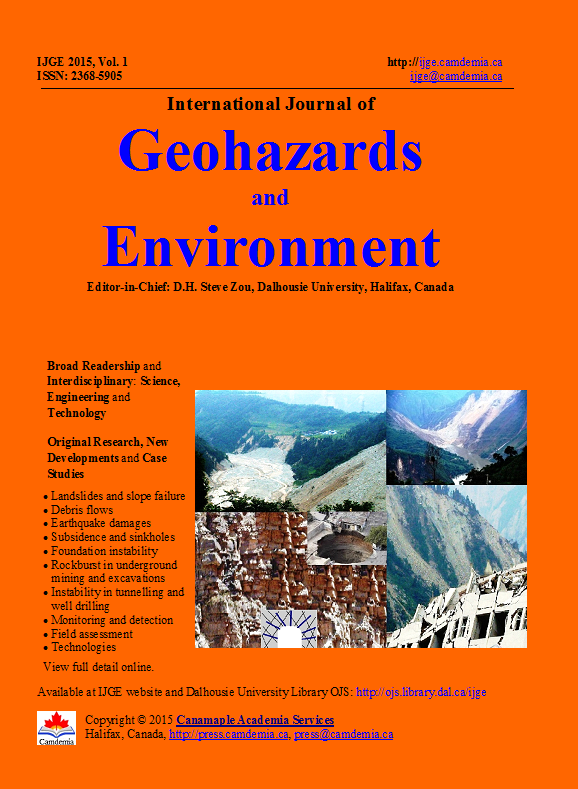A Phenomenological Model of Brittle Rocks under Uniaxial Compression
DOI:
https://doi.org/10.15273/ijge.2015.02.007Keywords:
crack closure behavior, microcrack damage, damage mechanics, phenomenological model, uniaxial compression testAbstract
A quantitative model was recently proposed by Peng et al (2015) to characterize the crack closure behavior of rocks. The model can simulate the initial nonlinearity of stress–strain curves in uniaxial and triaxial compressions. However, the crack propagation behavior near peak and in the post-peak deformation stage cannot be captured by the model. This paper extends the model to simulate the complete stress–strain curves of rocks under uniaxial compression. A phenomenological damage model, which uses a logistic function to describe the damage evolution, is adopted to model the pre-peak and post-peak deformation stages beyond the crack closure stage. Combining the crack closure model and the damage model yields a new phenomenological model. A uniform continuity condition is used to ensure that the stress–strain curve is smooth and continuous at the junction point of the crack closure model and the damage model. The proposed model has four model parameters, which can be calibrated using laboratory test data. The uniaxial compression tests of the Carrara marble under different heating cycles are simulated to verify the proposed model. The simulated stress–strain curves agree well with the test data, from initial crack closure to near peak and post peak, suggesting that the model can be used for simulating the entire deformation stage of brittle rocks with different degrees of initial microcrack damage.Downloads
Published
Issue
Section
License
Copyright, Terms and Conditions
The International Journal of Geohazards and Environment (the Journal) is published by Canamaple Academia Services (the Publisher) online with open access, under a Creative Commons Attribution-Noncommercial license (CC-BY-NC) (http://creativecommons.org/licenses/by-nc/4.0/). Authors (the Authors) submitting papers (the Work) for publication in the Journal automatically agree to the following terms and conditions.
1. Under the license (CC-BY-NC), Authors give permission for others to share and reuse the Work, as long as the original source and author(s) are properly cited (i.e. a complete bibliographic citation and link to the Journal website) and the material is not used for commercial purposes. Any sharing or reuse must however indicate the original CC-BY-NC license terms of the work.
2. Authors transfer and assign to the Publisher all copyright in and to the Work. However Authors retain all proprietary rights except the copyright, related to the Work and also retain the rights a) to use, reproduce, distribute, and publicly display the Work in any medium in connection with the Authors‘ academic and professional activities, such as teaching, presentations and lectures, b) to create derivative works from the Work and to make full use of the Work in future research and publications, c) to authorize others to make any non-commercial use of the Work, d) to make both the pre-published and final-published versions available online in institutional and/or disciplinary repositories or on their own websites with a citation and link to the original paper published in the Journal.
3. Authors warrant that the Work is their original work, it is not copied from anywhere or anyone else, they are totally responsible for the authenticity, originality, validity and accuracy, and the facts and views are their own, that the Work contains no matter which is defamatory or infringes any literary or proprietary rights, intellectual property rights, or any rights of privacy, and that the Work has not been simultaneously submitted to any other journals or publishers. Authors further agree that their manuscripts whether accepted or rejected will not be returned and the rejected manuscripts will be disposed at the journal editor's discretion.
Disclaimer: The Publisher, the Journal and the editors accept no responsibility for statements or opinions expressed by authors. Use of information and materials in the Journal is the sole responsibility of users.


